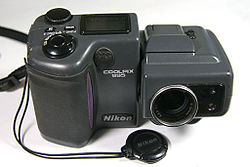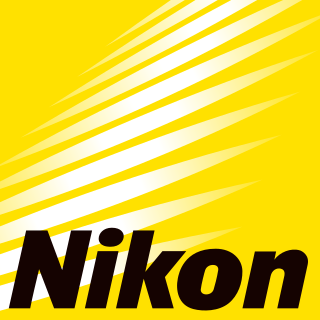
Nikon Corporation, also known just as Nikon, is a Japanese multinational corporation headquartered in Tokyo, Japan; it specializes in creating and marketing optics and imaging products. The companies held by Nikon form the Nikon Group.

The Nikon Coolpix 950 was a digital camera released by Nikon in early 1999. The 950 model superseded the Coolpix 900 in the Nikon Coolpix series. The Coolpix 950 was a durable camera with swivel lens, magnesium body, a maximum resolution of 1600×1200, 83× optical zoom and a minimum focusing distance of 2 cm. It was in turn superseded by the Coolpix 990.

The Canon PowerShot G is a series of digital cameras introduced by Canon in its PowerShot line in 2000. The G series cameras are Canon's flagship compact models aimed at photography enthusiasts desiring more flexibility than a point-and-shoot without the bulk of a digital single-lens reflex camera.

The Nikon FE is an advanced semi-professional level, interchangeable lens, 35 mm film, single-lens reflex (SLR) camera. It was manufactured by Nikon in Japan from 1978 to 1983, and was available new from dealer stock until c. 1984. The FE uses a metal-bladed, vertical-travel focal plane shutter with a speed range of 8 to 1/1000 second, plus Bulb, and flash X-sync of 1/125th second. It had dimensions of 89.5 millimetres (3.52 in) height, 142 mm (5.6 in) width, 57.5 mm (2.26 in) depth and 590 grams (21 oz) weight. It was available in two colors: black with chrome trim and all black. As on the FM, its model designation did not appear on the front of the camera, but was engraved as a small "FE" preceding the serial number on the rear of the housing.
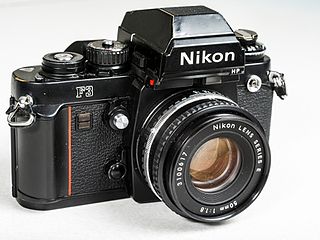
The Nikon F3 was Nikon's third professional single-lens reflex camera body, preceded by the F and F2. Introduced in 1980, it had manual and semi-automatic exposure control whereby the camera would select the correct shutter speed. The Nikon F3 series cameras had the most model variations of any Nikon F camera. It was also the first of numerous Nikon F-series cameras to be styled by Italian designer Giorgetto Giugiaro, and to include a red stripe on the handgrip – a feature that would later become a signature feature of many Nikon cameras.

The Nikon EM is a beginner's level, interchangeable lens, 35 mm film, single lens reflex (SLR) camera. It was manufactured by Nippon Kogaku K. K. in Japan from 1979 to 1982. The camera was designed for and marketed to the growing market of new photographers then entering the SLR buyer's market. The EM uses a Seiko MFC-E focal plane shutter with a speed range of 1 to 1/1000 second plus Bulb and flash X-sync of 1/90 second. It is 86 mm (3.4 in) high, 135 mm (5.3 in) wide, 54 mm (2.1 in) deep and weighed 460 grams (16 oz). Unlike most Nikons of the time, it was available only in black. The EM has no full manual exposure mode capability, but instead was intended to be used by inexperienced photographers who could not easily master the intricacies of shutter speeds and f-stops. There were also significant changes to the EM's mechanical and electrical components to reduce its production cost relative to previous Nikon cameras: dimensional tolerances weren't as tight, there were no ball bearings in the film advance mechanism, and no high-quality titanium shutter. The introductory US list price for the body plus normal lens was only $231.

The Nikon Coolpix 4500 is a digital camera — the penultimate model in the famous 950-995 lineup of swivel lens models. The last model was the Nikon Coolpix S4, most of its features match the Nikon 995. The Coolpix 4500 was announced by Nikon on May 29, 2002.

The Canon F-1 is a 35 mm single-lens reflex camera produced by Canon of Japan from March 1971 until the end of 1981, at which point it had been superseded by the New F-1 launched earlier that year. The Canon FD lens mount was introduced along with the F-1, but the previous Canon FL-mount lenses and older R- series lenses were also compatible with the camera with some limitations. The Canon F-1 was marketed as a competitor to the Nikon F and Nikon F2 single lens reflex cameras by Nikon.
Speedlight is the brand name used by Nikon Corporation for their photographic flash units, used since the company's introduction of strobe flashes in the 1960s. Nikon's standalone Speedlights have the SB- prefix as part of their model designation. Current Speedlights and other Nikon accessories make up part of Nikon's Creative Lighting System (CLS), which includes the Advanced Wireless Lighting, that enables various Nikon cameras to control multiple Nikon flash units in up to three separate controlled groups by sending encoded pre-flash signals to slave units.

The Nikon D200 is a 10.2-megapixel digital single-lens reflex camera that falls between entry-level/midrange DSLR cameras such as the Nikon D40, Nikon D40x, and D80 and high-end models such as the Nikon D2Hs and D2Xs. It was released by the Nikon Corporation in November 2005. The D200 was succeeded by the D300 in August 2007.
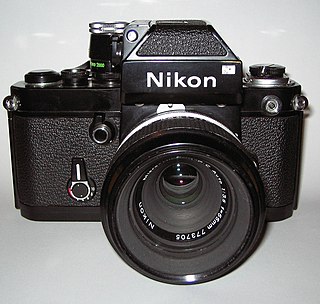
The Nikon F2 is a professional-level, interchangeable lens, 35 mm film, single-lens reflex (SLR) camera. It was manufactured by the Japanese optics company Nippon Kogaku K. K. in Japan from September 1971 to 1980. It used a horizontal-travel focal plane shutter with titanium shutter curtains and a speed range of 1 to 1/2000 second plus Bulb and Time, and flash X-sync of 1/80 second. It had dimensions of 98 mm height, 152.5 mm width, 65 mm depth and 730 g weight. It was available in two colors: black with chrome trim and all black. The F2 was adopted by both casual photographers and professional photographers, the latter of those especially photojournalists covering the later half of the Vietnam War.

The Nikon Coolpix 8400 is a digital camera announced September 16, 2004, succeeding the Nikon Coolpix 5400. It is a high-end model among the brand's range of bridge cameras with eight megapixels, only below the Nikon Coolpix 8800 equipped with a more powerful zoom lens. Besides its pixel count, its main selling point is the very wide angle lens, equivalent to a 24 mm in 135 film format. Its only competitor at a comparable price is the Kodak EasyShare P880, which has longer telephoto lens but is bigger and lacks a swivelling screen.

The Coolpix 5400 was a 5.1 megapixel 'prosumer' digital camera produced by Nikon. Announced at the end of May 2003 as the immediate successor to the Nikon Coolpix 5000, it features 4x optical zoom, 4x digital zoom, and many other functions.

The Coolpix S4 is a brand of digital camera produced by Nikon. Its image sensor is a CCD with 6.0 million pixels. It has a 2.5-inch (64 mm) thin-film transistor liquid crystal display device with 110,000 pixels. The S4 incorporates Nikon's popular swivel design which allows the addition of a powerful Nikkor 10X Optical zoom lens, yet retain a compact form. Other features include D-Lighting and Face-priority AF.

A swivel lens is a lens that freely rotates while attached to a camera body. They are used on some compact digital and video cameras (camcorders). These lenses make it easy for a photographer to aim a camera without moving around too much. Swivel lenses come in different sizes and shapes. A swivel lens is also known as a swiveling lens, swivelling lens, and rotating lens.

The Nikon D700 is a professional-grade full-frame digital single-lens reflex camera introduced by the Nikon Corporation in July 2008 and manufactured in Japan. It uses the same 12.1-megapixel "FX" CMOS image sensor as the Nikon D3, and is Nikon's second full-frame digital SLR camera.

The Coolpix S10 is a model of digital camera formerly produced by Nikon and first released in 2006 as part of the Coolpix Series. Its image sensor is a CCD with 6.0 million pixels. It has a 2.5-inch (64 mm) thin-film transistor liquid crystal display device with 230,000 pixels. The S10 incorporates Nikon's popular swivel design first seen in the Coolpix 900 which allows for a powerful Nikkor 10X Optical zoom lens while retaining a compact form. Other features include D-Lighting and Face-priority AF.

The D5000 is a 12.3-megapixel DX-format DSLR Nikon F-mount camera, announced by Nikon on 14 April 2009. The D5000 has many features in common with the D90. It features a 2.7-inch 230,000-dot resolution tilt-and-swivel LCD monitor, live view, ISO 200–3200, 3D tracking Multi-CAM1000 11-point AF system, active D-Lighting system and automatic correction of lateral chromatic aberration. The D5000 seems to have been discontinued in November 2010.
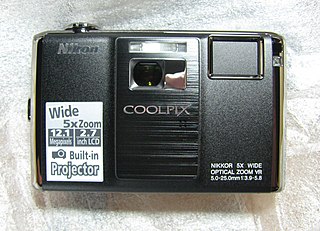
The Nikon Coolpix S1000pj is a compact digital camera manufactured by Nikon released in September 2009 as part of the Nikon Coolpix series. The S1000pj is the world's first compact camera to feature a built-in projector.

The Nikon D7000 is a 16.2-megapixel digital single-lens reflex camera (DSLR) model announced by Nikon on September 15, 2010. It replaced the D90 as the top end consumer camera, by using much of the technology and controls from the earlier D5000, in a larger more robust body similar to the flagship D300 series. In some ways it was superior to the D300S, though for several years the two cameras were both available with the D300 positioned as the flagship in Nikon marketing materials.
